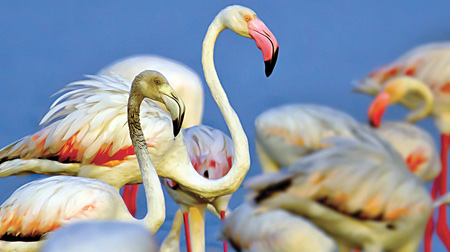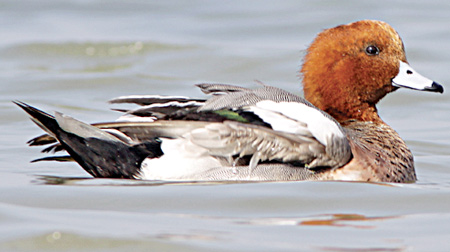Will
they be avian deathtraps?
Mannar wind farm where migratory birds landfall
By Maneshka Borham
 In July this year the Public Utilities Commission of Sri Lanka (PUSL) created
serious concern among the public when it was announced that Sri Lanka is now
moving towards a major power crisis if appropriate action is not taken by 2018.
The PUSL warning the Ceylon Electricity Board (CEB) had said that under drought
conditions and even with planned plant additions, Sri Lanka is set to face
energy capacity shortages in 2018 and beyond. ¨Due to drought conditions, the
planned plant additions too may be inadequate and new options should be
perused,¨ the PUSL had said. In July this year the Public Utilities Commission of Sri Lanka (PUSL) created
serious concern among the public when it was announced that Sri Lanka is now
moving towards a major power crisis if appropriate action is not taken by 2018.
The PUSL warning the Ceylon Electricity Board (CEB) had said that under drought
conditions and even with planned plant additions, Sri Lanka is set to face
energy capacity shortages in 2018 and beyond. ¨Due to drought conditions, the
planned plant additions too may be inadequate and new options should be
perused,¨ the PUSL had said.
The looming power crisis has increased the urgency for the CEB to find other
sources of energy but reliability and environmental concerns plague their
choices at hand; whether it be wind power, liquefied natural gas (LNG) or solar
power.
Today, non-conventional renewable energy (NCRE)amounts to only 9.9 percent of
Sri Lanka’s total power generation, according to the Central Bank and the
government in its energy policy has set a target to generate 20 per cent of the
country’s power needs through NCRE sources by 2020.
With the Sri Lanka Sustainable Energy Authority (SLSEA) identifying the
potential generation of wind power approximately 375 MW in the Mannar region,
yet another wind farm has been commissioned to be built in Mannar with the
Department of Coast Conservation recently giving the go-ahead and clearing the
project of any potential negative environmental impact.
 Despite requiring significant investment, wind power is, perhaps, one of the
cleanest forms of energy produced, not requiring the burning of fossil fuels,
and is renewable due to constant availability making it an ideal renewable
energy option for Sri Lanka. According to the Intergovernmental panel on Climate
Change compared with other low carbon sources, wind turbines have the lowest
global warming potential per unit of electricity generated. Despite requiring significant investment, wind power is, perhaps, one of the
cleanest forms of energy produced, not requiring the burning of fossil fuels,
and is renewable due to constant availability making it an ideal renewable
energy option for Sri Lanka. According to the Intergovernmental panel on Climate
Change compared with other low carbon sources, wind turbines have the lowest
global warming potential per unit of electricity generated.
However, despite the form of energy generation being environmentally friendly,
environmentalists in the country have now raised grave concerns regarding the
proposed Mannar wind farm due to its location and its effect on the migrant bird
population arriving in the island.
Location
The adverse connection between wind farms and birds is a common problem and
perhaps the main criticism faced by wind farms the world over with large
spinning turbines being called bird deathtraps, as they cut through the flying
space of birds, turning at over 300 kilometres per hour resulting in a large
number of bird deaths annually. While the actual numbers are a point of
contention, it is believed bird mortality at wind energy facilities can vary,
depending on the location, construction, and height, with some facilities
reporting zero bird fatalities, and others as high as 9.33 birds per turbine per
year according to one research report.
The location chosen by the CEB for the wind power plant lies on the southern
shore of Mannar island between the Adam´s Bridge Marine National Park and the
Vankalai Sanctuary, a declared International Ramsar Wetland. According to
leading environmentalists, and the Ceylon Birds Club, Mannar Island is an
internationally recognised Important Bird and Biodiversity Area (IBA),
consisting of wetlands and nature reserves, home to over 190 species of birds,
and therefore, constructing such a wind farm could contribute to a large number
of avoidable avian fatalities.
According to the Ceylon Birds’ Club Joint Secretary Kithsiri Gunawardene the
main issue is with the locality of the wind farm he says, adding that research
and historical records of the club has proved this area is in fact where
migratory birds first land during their long and arduous journey to escape the
harsh winter of their home countries, from September to April.
 Senior Lecturer of the Wayamba University Dr. Sevvandi Jayakody confirms this.
¨The proposed wind farm is obstructing a well known route taken by migratory
birds,¨ she said. Senior Lecturer of the Wayamba University Dr. Sevvandi Jayakody confirms this.
¨The proposed wind farm is obstructing a well known route taken by migratory
birds,¨ she said.
According to experts, yearly, migratory birds take two main routes to the
country, one being the route from Rameshwaram, India over the cluster of islands
known as Adam’s Bridge to reach the Vankalai bird sanctuary in Mannar. This,
according to environmentalists, has, therefore, contributed to the increase of
bird population, with birds from countries such as Russia, Belarus, China and
Mongolia using the route to migrate. While over one million birds enter the
island through this route annually, environmentalists claim the proposed wind
farm will be hazardous and claim many fatalities, if built on the proposed site.
Gunawardene says, Mannar is a sensitive and important site for seabirds such as,
the Crab Plover, Flamingos, Bridled Tern and the Roseate Tern. Ornithologists
say, many migratory birds to Urumalai in Mannar landfall during night time
before going on to Vankalai. According to Gunawardene, Sri Lanka being the last
point of travel for many migratory birds, the construction of such a farm, while
obstructing the path of birds who are fatigued, having travelled thousands of
kilometres to reach Sri Lanka, will cause disastrous consequences. “The proposed
wind farm is along this landfall area,” he says.
Initial report
Environmentalists have also expressed their displeasure at the Initial
Environment Examination (IEE) by a team led by Professor in Zoology Devaka
Weerakoon, University of Colombo. According to Sajeewa Chamikara of the
Environment Conservation Trust, the report is inadequate to understand the
environmental situation in the area. “Much data is lacking from the report. All
areas of concern have not been looked into,” he said.
 “The birds landfall during the night and do this over several months of the
year,” says Gunawardene. “The truth should not be suppressed as it can have
unpleasant consequences. When the farm is built, it will not be commercially
viable to dismantle it if found to adversely affect the animals,” he says. “The birds landfall during the night and do this over several months of the
year,” says Gunawardene. “The truth should not be suppressed as it can have
unpleasant consequences. When the farm is built, it will not be commercially
viable to dismantle it if found to adversely affect the animals,” he says.
According to Dr. Sevvandi Jayakody the issue also brings into perspective the
scientific methodology and processes used in creating reports needed to give
clearance to various projects. ¨Repeatedly we see that such erroneous reports
are the main cause for serious environmental issues in the country” she said.
Legal Aspect
¨The IEE claims, 18 hours was spent at each of the six assigned vantage points
to collect data,¨ she says questioning if this time is adequate to collect data
despite the report taking over two years to be completed. While the report then
claims that bird population during migration and other times remains the same,
Dr. Jayakody says she is confused as to how this conclusion was arrived at when
only a short time was spent at each point to collect the needed data. ¨The data
collected by the Ceylon Bird Club proves otherwise and shows a large increase of
birds in the area during migration periods,¨ she said.
 Earlier, CEB Chairman Anura Wijepala assured that proper procedure will be
adhered to during the project. “We chose Mannar as it is one of the best spots
for wind power generation,” he said adding that Mannar along with several other
sites have been chosen for proposed wind farms due to their suitability in a
move to increase non-conventional renewable energy generation methods in the
country. Earlier, CEB Chairman Anura Wijepala assured that proper procedure will be
adhered to during the project. “We chose Mannar as it is one of the best spots
for wind power generation,” he said adding that Mannar along with several other
sites have been chosen for proposed wind farms due to their suitability in a
move to increase non-conventional renewable energy generation methods in the
country.
“The EIA has not been concluded. Once it is done, we will submit it to the
public for their opinions and concerns,” he said in June this year.
“The CEB has no mandate to work against the law” Wijepala said adding that the
CEB will at all times comply with the environmental laws of Sri Lanka.
However according to environmentalists despite assuring an EIA, the Coast
Conservation Department has now approved the project based on the IEE done.
According to Environmentalist and Lawyer Jagath Gunawardena, rightfully such
approval should be granted by the Department of Wildlife protection under the
Flora and Fauna Protection Ordinance if any development project is being
constructed within a mile’s radius from a national park, and in this instance
the Adamś Bridge marine National Park. ¨However despite this the Coast
Conservation Department was named as the approving authority¨ he said adding
that this created loopholes to get the project approved.
 Legally the Coast Conservation Department can approve a project after calling
for an IEE or an Environment Impact Assessment EIA (EIA) under the Coast
Conservation Act under the Coast Conservation Act. However, unlike under the
Flora and Fauna Ordinance legally the Coast Conservation Act does not require
the approving authority to seek public opinion on the matter allowing the
project to be approved sans any opposition. According to Gunawardene as required
the report has not been submitted to review by the Coast Conservation Advisory
Board, a serious lapse on the part of the department. Legally the Coast Conservation Department can approve a project after calling
for an IEE or an Environment Impact Assessment EIA (EIA) under the Coast
Conservation Act under the Coast Conservation Act. However, unlike under the
Flora and Fauna Ordinance legally the Coast Conservation Act does not require
the approving authority to seek public opinion on the matter allowing the
project to be approved sans any opposition. According to Gunawardene as required
the report has not been submitted to review by the Coast Conservation Advisory
Board, a serious lapse on the part of the department.
Alternatives
While reiterating that they are in support of renewable energy projects,
Gunawardene says their request is that the wind farm should be constructed in an
area between Silawathurai and Arippu. “There is ample wind and no harm to the
migratory patterns of birds in these areas,” he says adding that it would be the
ideal win-win situation.
“Birds protect the equilibrium of the environment by keeping insects that
multiply fast in control,” Gunawardene says adding that they are the cleansers
of the environment. |

